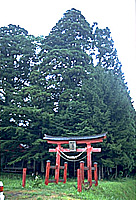
The shrine at Ubayashiki village. The cedar in the picture is said to be 600 years old. |
The farm and its environs was one of Kenji's favorite places; he visited it often and loved to walk through the fields there.
"Koiwai Farm," contained in Kenji's poetry collection Spring and Ashura, is one of his most famous poems.
Kenji would stroll through the farm, past Ubayashiki village, until he reached Mt. Kurakake.
The places he discovered on his strolls became the settings for numerous poems and stories.
Ubayashiki village is thought to be the model for " Wolf Forest, Colander Forest, Thief Forest" a story about some farmers who build a village.
Even today the atmosphere of Ubayashiki is suggestive of villagers living in harmony with the forests
and animals around them.
The bulletin board in what is left of the Ubayashiki Elementary School states: Abe no Sadato, who fought in the Earlier Nine Years' War, was finally defeated by the Minamoto no Yoshi clan, but Abe's nursemaid (and half-sister) escaped to safety and settled here, thus the origin of the name Ubayashiki, or the Old Woman's Residence.
That mountain in the distance covered with black pine is Wolf Forest. How fresh and lush it is.
Yes, that's it. Judging by the map
You'd think it would be taller,
But that's all there is.
If you take the right shoulder, there's a downhill slope.
The elementary school in Ubayashiki can probably be seen from there.
I'm tired of going through Yanagizawa.---------
 A mist over Koiwai Farm |
No, that's a bore [going home early]. It's not as good as
Being outdoors in a wide-open place like this.
Everywhere but out in the fields I always feel how small I am,
I guess I'll go through Yanagizawa after all.
In the dismal mist
Beethoven, his sturdy black shoulders squared and
Head drooped low, occasionally growls to himself
As he tramps over the fields far and wide.
The Complete Works of Miyazawa Kenji Vol.1, Chikuma Bunko
The origin of the names Wolf Forest, Big Basket Forest, and Thief Forest, from Waga Kurosaka Mori (My Black Forest) by Fumio Ishikawa.

|
There are two theories about how the Thief Forest came by its name. One holds that Ohtakemaru, a descendent of the ninth-century Ainu chieftain Aterui, rebelled against the court. He was very popular with the local people; but the court, wanting by all means to eradicate Ohtakemaru's good name, called him "Terrible Taro" or "The Great Thief," making him out to be an evil and devilish character who carried off women and children. The Thief Forest is said to be the one from which Ohtakemaru carried out his revolt against the court.
The other theory has it that the name-in Japanese Nusuto Mori-is a corrupted form of Nishibi no Ataru Mori which means the "woods shone on by the afternoon sun." Certainly, Mt.Yakegiri lies in the way of these woods, so the rising sun is late to shine down on them. But there's nothing west of the forest to cut off the afternoon sun as far as Mt. Takakura, so nothing prevents it from shining down on the forest until evening.
